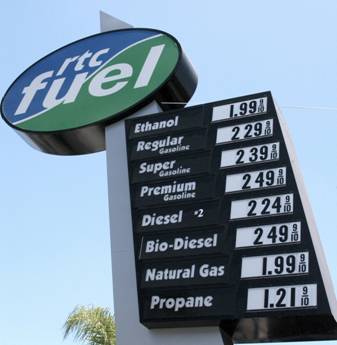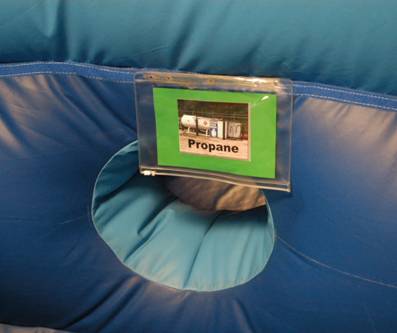
ECO-Center at San Diego’s Regional Transportation Center
If you had suggested to me when I first started to drive in the late 60s that I would eventually become a (reluctant) champion for alternative fuels and economical vehicles, I can only imagine what my response to you would have been. I would probably have said that you were nuts. After all, my first car was a Plymouth Duster 340 muscle car. Tire-smoking burnouts and long drives to nowhere in particular, solely for the pleasure of driving, were the order of the day for me. Gas was cheap and plentiful back then. Oh, how the times have changed.
Fast forward to 2004. The price of gas at the pumps has soared and, I strongly suspect, while there may be pauses along the way we will probably experience continuing increases. $3/gallon for gas is not far off. What’s next: $4, $5 – who knows what is coming and when? At one point recently it cost me $25 to fill the small gas tank in my Focus with regular unleaded. I can only imagine what owners of large SUVs have been paying to fill up.
Our nation’s truckers face similar increases. It is just a matter of time before significantly higher fuel prices will be reflected in the prices we all have to pay for our goods. For me and, no doubt, for many of you, the latest round of increases was the last straw, the final nail in the coffin for an affordable supply of gasoline. Now, more than ever, we all are finally thinking about, and seriously discussing, transportation alternatives.
I have finally shifted into a mindset of long-term fuel conservation. I have reluctantly come to the realization that I cannot continue acting as if I live in a dream world of readily available, cheap gasoline, which had fueled our demand for ever-larger and increasingly gas-guzzling vehicles. Those days are gone, probably forever. We need to get away from gas-guzzlers – at least for our daily drivers, and that shift is happening now.
A visit to your local Toyota dealer will prove that point. Just ask a salesperson how sales of their hybrid Prius are going. Better yet, try to buy one. Good luck. The last I heard the waiting list is between six months and a year – depending on the options you want, and the price of those options has effectively gone way up because the reduced number of option packages group more of the popular ones together, adding significantly to the vehicles’ selling prices.
As is that wasn’t bad enough, our federal government is scaling back the generous tax deduction offered to early adopters of the hybrid vehicles. As I understand it, the one-time deduction is down to $1500 this year, and will be followed by a further reduction to $1,000 for buyers next year – supposedly the final year of the program. No doubt that is also fueling the demand for the few hybrid vehicles currently available. In our vast market, where are the hybrids (or viable alternatives) from mighty GM and Chrysler, or from Nissan, Mercedes and BMW, to mention just a few? We demand hybrids now but there are not enough available. At least Volkswagen is apparently making some real headway with a new generation of economical, cleaner diesels.
With this as a backdrop and with our fuel prices vying for the dubious honor of being at or among the highest in our nation, it is fitting that San Diego is the home for the new ECO-Center. It is located in the ultra-modern Regional Transportation Center (RTC), at 4001 El Cajon Boulevard. The RTC is billed as the first place in the world that sells alternative fuels and vehicles. That should be your first clue that something special is going on here.
Those of you who have driven by this location may have already noticed their distinctive blue and green “rtc fuel” sign. A closer look at that sign would have revealed to you that this is not just another new brand of gasoline. In contrast to the typical gas station signs that advertise prices for regular, mid-grade, premium and diesel, the RTC adds Ethanol, Bio-Diesel, Natural Gas and Propane.
It is at the RTC that you can buy a Segway, “a fun way to help alleviate urban congestion, air pollution and dependence on gas and oil.” I had the opportunity to ride one and I really like it.
Also at the RTC you will find the state-of-the-art, 6,000 square foot ECO-Center. It features wonderfully creative, interactive exhibits and a spacious theatre filled with comfortable seats from Ford’s Focus model. Thousands of our 5th to 7th grade children will annually come here on field trips from our schools, at least for now free of charge, to learn about alternative fuels and vehicles.
The ECO-Center even has its own, natural gas-powered school bus to bring the students there. On guided field trips “students will help create cleaner cities, learn about alternative fueled vehicles, find out what makes a hybrid car, see an actual fuel cell and learn about the promise of the Hydrogen Economy.”
Kids especially love exploring the clever and educational ‘alternative fuel maze.’ As they work their way through its padded twists and turns, they interactively learn about and ‘build’ alternative-fueled vehicles.
Students learn, through positive, real-world examples, about “the consequences of societal decisions regarding how cities’ decisions impact the environment,” and how various actions and technologies can come together to create a “Clean City.”
Exhibits explain how fuel cells generate electricity from hydrogen, expose students to the ways that hybrids achieve lower pollution emissions and educate students on the various types of alternative fueled vehicles, highlighting their respective benefits. A special movie was commissioned to “give a dramatic overview of the history of the earth and human development,” “explore how technology and population growth has led to air pollution and the need for cleaner vehicles,” “encourage students to see how air quality affects their lives” and “educate students on the radically different energy future which they will experience during their lifetimes.”
Earlier I mentioned that the students currently attend the ECO-Center free of charge. The ECO-Center is a key project of the San Diego Environmental Foundation (SDEF) and is funded by generous corporate and individual benefactors who are concerned about our future. That list includes the San Diego County Office of Education, Ford Motor Company, San Diego County and its Air Pollution Control District, and John McCallan, among others. Fundraising efforts are ongoing. If you or your company would like to help in this very worthwhile endeavor, please contact the SDEF through their Website: www.sdecocenter.org. Your support is needed. Our future depends on it.
Drive safely and do join me again next time.










